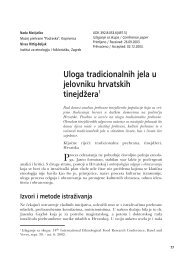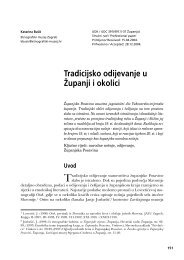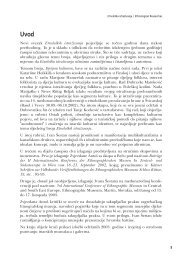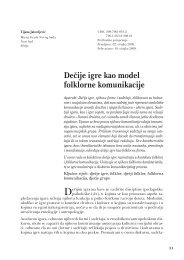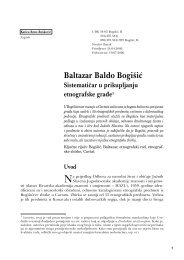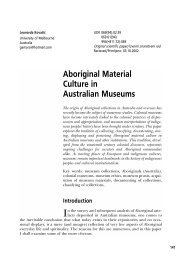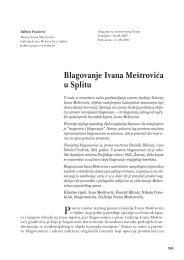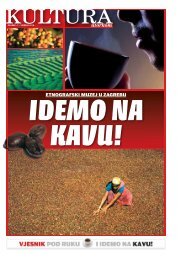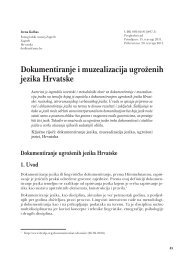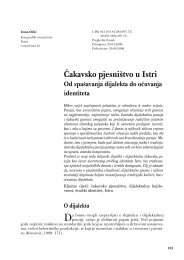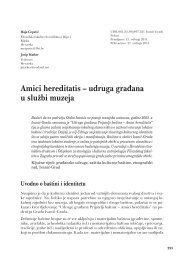Etnoloska istrazivanja / Ethnological researches - EMZ
Etnoloska istrazivanja / Ethnological researches - EMZ
Etnoloska istrazivanja / Ethnological researches - EMZ
Create successful ePaper yourself
Turn your PDF publications into a flip-book with our unique Google optimized e-Paper software.
Etnološka istraživanja 15/<strong>Ethnological</strong> Researches 15With our knowledge of the genesis of the national costume it is interesting to observethe social dynamics of the concept and the significance of the region in the life of thecostume as a cultural good in our own times. 49 In additional to the administrativesense, the conception of the region continues to be realted to the market. 50 Duringthe last two decades the vitality of cultural practices in administrative procedures hasbeen boosted by the implementation of the legal protection of collective practices inthe form of immaterial cultural goods. Just as at the time when visits by state foresters,teachers, gendarme, physicians and recruiting commissioners replaced the visitsby feudal estimators of the harvest and the peasants noted the interest these newenlightened and Romantic officials had for the characteristics of their hand-wroughtartefacts, today the new space of demand enhanced by the technologically updatedmeans of supply is perceived in the same manner. Every time that a person dressedin the national costume appears in a front of a sponsor’s commercial logotype whatwe have is the marketing of cultural goods deriving from the partially inherited andpartly from the creative facility of the cultural industry of experience, of value to thelocal community and to the communication tissue of constructing taste. To an extent,more or less indirectly, the practicing of socially responsible entrepreneurship counterssuch marketing.Far distant from local sites, after the state initiatives of decolonized African countriesand South American countries such as Bolivia and Peru, because of the market exploitationof their heritage, in the documents of UNESCO and WIPO the “folklore” definitionsof collective forms of protected cultural practices are modified into formulationssuch as “cultural and intellectual ownership”, “Traditional knowledge”, “culturalexpression” and others (Lucas-Schoetter 2004: 264). This market tide sets afloat“folklore” (the word coined by the English archeologist W.G. Thoms in 1846), that is,“the national treasure” and “national art” with the national costume as its prominent49It has been observed how the so-called spatial units for statistics of the second order (regions, provinces)in the countries that have enetered the European Union acquired not only statistical features but thosefeatures associated with administrative wholes. Whether this means that some future inhabitants ofthe third Croatian spatial unit for statistics of the second order will consider themselves Adriatic (in theso-called Adriatic statistical region of Croatia) and design for their dress some kind of „Adriatic“ culturalitem conceived in constct with other provincials from the countries of the European Union is bizarreto imagine but might be interesting to observe.50Scholars of the Mediterranean have observed how the definitional perception of the Mediterraneanaccords with the prospects of tourism. Nine existing Mediterraneanoid natural regions define he mostexplicit of all the attributes of the Mediterranean, the climatic one, as rare and recent excesses which assuch are all the more emphatically emphasized (Grove and Rackham). While social anthropologists (thosewho instituted „Mediterranean studies“) never came to a consensus as to where precisely lies the southeasternboundary of the Mediterranean, experts who deal with these Mediterranean shores and accessesdo not even designate themselves with the Mediterranean label. Another example of the business definitionof this large operative „region“ at the time of writing this article can be gleaned from newspaperaccounts which, after Bavaria sold off its shares and Austria nationalized the bank Hypo-Alpe-Adria,have reconstructed the field and the scope of the bank’s financial speculations. The bank served as a treasuryfor the redistribution of the social wealth of the European Southeast during the 1990is and as a renowneddeparture point of capital for the consumption of available resources such as the coastal area forreal estate construction. In an unusual manner, the vitality of the operative „region“ after the genesis ofthe concept of the national costume is reconfirmed two centuries later.224



